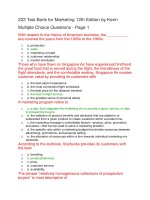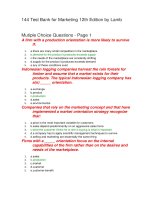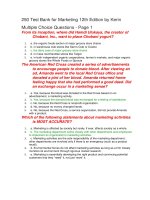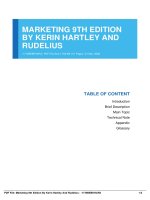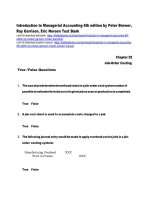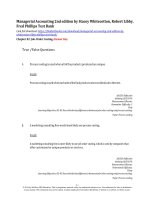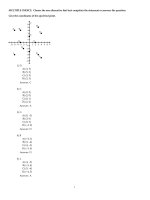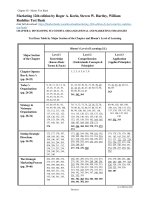Marketing 12th edition by kerin hartley rudelius test bank
Bạn đang xem bản rút gọn của tài liệu. Xem và tải ngay bản đầy đủ của tài liệu tại đây (2.52 MB, 157 trang )
Chapter 02 - Master Test Bank
Marketing 12th edition by Roger A. Kerin, Steven W. Hartley, William
Rudelius Test Bank
Link full download: />CHAPTER 2: DEVELOPING SUCCESSFUL ORGANIZATIONAL AND MARKETING STRATEGIES
Test Item Table by Major Section of the Chapter and Bloom’s Level of Learning
Bloom’s Level of Learning (LL)
Major Section
of the Chapter
Level 1
Knowledge
(Knows Basic
Terms & Facts)
Level 2
Comprehension
(Understands Concepts &
Principles)
Level 3
Application
(Applies Principles)
1, 2, 3, 4, 5, 6, 7, 8
Chapter Opener:
Ben & Jerry’s
(pp. 24-25)
Today’s
Organizations
(pp. 26-28)
9, 10, 11, 12, 13, 14,
15, 16, 17, 18, 19,
20, 27, 28, 31, 32,
33, 35, 36, 44, 45,
52, 53, 54, 55, 57,
58, 62, 65, 66
21, 22, 29, 30, 34, 37, 38, 39, 40,
41, 42, 43, 46, 47, 48, 50, 51, 56,
59, 60, 63, 64, 67
361, 362, 364
23, 24, 25, 26, 49, 61,
68, 69
Strategy in
Visionary
Organizations
(pp. 28-34)
83, 84, 85, 91, 92,
94, 95, 96, 105, 106,
111, 112, 113, 116,
117, 119, 121, 122,
124, 126, 132, 133,
134, 153, 154, 156,
157, 160, 161, 163
376
70, 71, 72, 73, 74, 75, 76, 77, 78,
79, 80, 81, 82, 86, 87, 88, 93, 97,
98, 99, 100, 101, 104, 107, 110,
114, 115, 120, 123, 125, 127, 128,
129, 136, 140, 144, 145, 148, 151,
152, 155, 158, 159, 162, 164, 165,
166, 167, 168, 169, 170, 171
365, 366, 368, 369, 370, 371, 373,
374
89, 90, 102, 103, 108,
109, 118, 130, 131, 135,
137, 138, 139, 141, 142,
143, 146, 147, 149,
150
367, 372, 375
Setting Strategic
Directions
(pp. 34-39)
172, 177, 178, 187,
188, 189, 193, 194,
195, 196, 197, 199,
200, 201, 204, 205,
208, 209, 211, 212,
230, 231, 233, 234,
239, 240, 243, 244,
247, 248
173, 183, 184, 186, 190, 191, 192,
198, 202, 206, 210, 213, 214, 216,
217, 218, 219, 220, 228, 229, 232,
235, 236, 241, 249, 252, 253, 255,
258, 260, 263
377, 378, 379, 380
174, 175, 176, 179, 180,
181, 182, 185, 203, 207,
215, 221, 222, 223, 224,
225, 226, 227, 237, 238,
242, 245, 246, 250, 251,
254, 256, 257, 259, 261,
262
The Strategic
Marketing Process
(pp. 39-46)
264, 265, 268, 274,
275, 277, 293, 294,
295, 299, 300, 301,
302, 303, 304, 305,
306, 307, 311, 312,
318, 319, 330, 331,
335, 336, 341, 345,
346
266, 267, 269, 270, 271, 272, 273,
278, 282, 283, 284, 289, 290, 291,
292, 296, 298, 308, 309, 310, 313,
314, 315, 316, 317, 320, 321, 322,
323, 324, 327, 329, 332, 333, 337,
340, 342, 343, 344, 347, 348, 349,
351, 352, 355
381, 382, 383, 384, 386, 388, 389,
390, 391, 392, 393
276, 279, 280, 281, 285,
286, 287, 288, 297, 325,
326, 328, 334, 338, 339,
350, 353, 354, 356
385, 387
-
363
nt of McGraw-Hill
Education.
Chapter 02 - Master Test Bank
Video Case 2: IBM
(pp. 48-49)
357
358, 359, 360
NOTE: Bold numbers indicate short essay questions. Underlined numbers indicate visually enhanced questions. 2-1
Copyright © 2015 McGraw Hill Education. All rights reserved. No reproduction or distribution without the prior written conse
CHAPTER 2: MASTER TEST BANK
DEVELOPING SUCCESSFUL ORGANIZATIONAL AND MARKETING STRATEGIES
Test Item Table by Learning Objective and Bloom’s Level of Learning
Lea
Bloom’s Level of Learning (LL)
rning Objective
(LO)
LO 2-1 Describe three kinds
of organizations
and the three levels of
strategy in them.
Level 1
Knowledge
(Knows Basic Terms
& Facts)
Level 2
Comprehension
(Understands Concepts &
Principles)
Level 3
Application
(Applies Principles)
9, 10, 11, 12, 13, 14, 15,
16, 17, 18, 19, 20, 27,
28, 31, 32, 33, 35, 36,
44, 45, 52, 53, 54, 55,
57, 58, 62, 65, 66, 357
21, 22, 29, 30, 34, 37, 38, 39, 40, 41,
42, 43, 46, 47, 48, 50, 51, 56,
59, 60, 63, 64, 67
361, 362, 364
23, 24, 25, 26, 49, 61,
68, 69
363
LO 2-2 Describe core values,
mission,
organizational
culture, business, and
goals. (pp. 28-32)
83, 84, 85, 91, 92, 94, 95,
96, 105, 106, 111,
112, 113, 116, 117, 119,
121, 122, 124, 126, 132,
133, 134, 153, 154
1, 2, 3, 4, 5, 6, 7, 8, 70, 71, 72, 73,
74, 75, 76, 77, 78, 79, 80, 81, 82,
86, 87, 88, 93, 97, 98, 99, 100, 101,
104, 107, 110, 114, 115, 120, 123,
125, 127, 128, 129, 136, 140, 144,
145, 148, 151, 152, 155
365, 366, 368, 369, 370, 373, 374
89, 90, 102, 103, 108,
109, 118, 130, 131, 135,
137, 138, 139, 141, 142,
143, 146, 147, 149, 150
367, 371, 372, 375
LO 2-3 Explain
managers
156, 157, 160, 161, 163
376
158, 159, 162, 164, 165, 166, 167,
168, 169, 170, 171
172, 177, 178, 187, 188,
189, 193, 194, 195, 196,
197, 199, 200, 201, 204,
205, 208, 209, 211, 212,
230, 231, 233, 234, 239,
240, 243, 244, 247, 248
173, 183, 184, 186, 190, 191, 192,
198, 202, 206, 210, 213, 214, 216,
217, 218, 219, 220, 228, 229, 232,
235, 236, 241, 249, 252, 253, 255,
258, 260, 263, 358
377, 378, 379, 380
174, 175, 176, 179, 180,
181, 182, 185, 203, 207,
215, 221, 222, 223, 224,
225, 226, 227, 237, 238,
242, 245, 246, 250, 251,
254, 256, 257, 259, 261,
262
264, 265, 268, 274, 275,
277, 293, 294, 295, 299,
300, 301, 302, 303, 304,
305, 306, 307
266, 267, 269, 270, 271, 272, 273,
278, 282, 283, 284, 289, 290, 291,
292, 296, 298, 308, 309, 310, 359
381, 382, 383, 384, 386
276, 279, 280, 281, 285,
286, 287, 288, 297
385, 387
(pp. 26-28)
why
use
marketing
dashboards
and
marketing metrics.
(pp. 32-34)
LO 2-4 Discuss how an
organization
assesses where it is
now and where it
seeks to be. (pp.
34-39)
LO 2-5 Explain the three steps
of the planning phase
of the strategic
marketing process.
(pp. 39-42)
-
nt of McGraw-Hill
Education.
Chapter 02 - Master Test Bank
LO 2-6 Describe the four
components of the
311, 312, 318, 319, 330,
331, 335, 336
313, 314, 315, 316, 317, 320, 321,
322, 323, 324, 327, 329, 332, 333,
337, 360
388, 389, 390
325, 326, 328, 334, 338,
339
9, 10, 11, 12, 13, 14, 15,
16, 17, 18, 19, 20, 27,
28, 31, 32, 33, 35, 36,
44, 45, 52, 53, 54, 55,
57, 58, 62, 65, 66, 357
21, 22, 29, 30, 34, 37, 38, 39, 40, 41,
42, 43, 46, 47, 48, 50, 51, 56,
59, 60, 63, 64, 67
361, 362, 364
23, 24, 25, 26, 49, 61,
68, 69
363
implementation
phase of the strategic
marketing process.
(pp. 42-44)
LO 2-7 Discuss
how
managers
identify
and act on deviations
from plans. (pp. 4446)
NOTE: Bold numbers indicate short essay questions. Underlined numbers indicate visually enhanced questions.
2-2
Copyright © 2015 McGraw Hill Education. All rights reserved. No reproduction or distribution without the prior written conse
CHAPTER 2: MASTER TEST BANK
DEVELOPING SUCCESSFUL ORGANIZATIONAL AND MARKETING STRATEGIES
MULTIPLE CHOICE QUESTIONS
2-1 CHAPTER OPENER: BEN & JERRY’S
COMPREHENSION
Ben & Jerry’s is founded on and dedicated to a sustainable corporate concept of linked
prosperity.
Its mission consists of three interrelated parts: Ben & Jerry’s product mission is to make,
distribute, and sell the finest quality all natural ice cream and euphoric concoctions with
a. milk obtained exclusively from large nationally certified dairies that use bovine growth
hormone.
b. the intent of making modest profits without sacrificing high product quality standards.
c. ingredients that are all completely organic and are available only in Vermont to ensure
freshness and contribute to the local economy.
d. a commitment to incorporating wholesome, natural ingredients and promoting business
practices that respect the earth and the environment.
e. ingredients that come exclusively from developed countries promoting Fair Trade practices.
Answer: d
Page(s): 24-25
LO: 2-2
AACSB: Analytic
QD: Medium
Rationale: Ben & Jerry’s product mission is to make, distribute, and sell the finest quality all
natural ice cream and euphoric concoctions with a continued commitment to incorporating
wholesome, natural ingredients and promoting business practices that respect the Earth and the
Environment.
2-2 CHAPTER OPENER: BEN & JERRY’S
COMPREHENSION
2-3
Copyright © 2015 McGraw-Hill Education. All rights reserved. No reproduction or distribution without the prior written consent of McGraw-Hill
Education.
Chapter 02 - Master Test Bank
Ben & Jerry’s is founded on and dedicated to a sustainable corporate concept of linked
prosperity. Its mission consists of three interrelated parts: Ben & Jerry’s social mission is to
operate the company in a way that actively recognizes the central role that business plays in
society by a. promoting the quality concept through its commitment to making the finest ice
cream.
b. giving its stakeholders the greatest possible input into company marketing decisions.
c. generating enough revenue to be a completely nonprofit organization.
d. donating 10% of its net profits to local charitable causes and an additional 5% to support
producers that practice sustainable farming.
e. initiating innovative ways to improve the quality of life locally, nationally and
internationally.
Answer: e
Page(s): 24-25
LO: 2-2
AACSB: Analytic
QD: Medium
Rationale: Ben & Jerry’s social mission is to operate the Company in a way that actively
recognizes the central role that business plays in society by initiating innovative ways to improve
the quality of life locally, nationally and internationally.
2-3 CHAPTER OPENER: BEN & JERRY’S
-
COMPREHENSION
nt of McGraw-Hill
Education.
Chapter 02 - Master Test Bank
Ben & Jerry’s is founded on and dedicated to a sustainable corporate concept of linked prosperity.
Its mission consists of three interrelated parts: Ben & Jerry’s economic mission is to operate the
company
a. with the goal of generating enough revenue to be a completely nonprofit organization.
b. on a sustainable financial basis of profitable growth, increasing value for our stakeholders and
expanding opportunities for development and career growth for our employees.
c. with the goal of making profits for selected charitable organizations such as Fair Trade.
d. with the goal of increasing market share not only in ice cream sales but also in its retail
clothing and accessories merchandise lines.
e. with the goal of expanding into international markets by developing sustainable dairies for
developing nations.
Answer: b
Page(s): 24-25
LO: 2-2
AACSB: Analytic
QD: Medium
Rationale: Ben & Jerry’s economic mission is to operate the Company on a sustainable financial
basis of profitable growth, increasing value for our stakeholders and expanding opportunities for
development and career growth for our employees.
2-4 CHAPTER OPENER: BEN & JERRY’S
COMPREHENSION
In keeping with its business mission, Ben & Jerry’s
a. created a children’s TV program with cat and mouse cartoon characters “Ben” and “Jerry” to
teach about the importance of good nutrition and Fair Trade sustainable business practices.
b. offered to buy out any failing family-owned ice cream parlor and turn it into a ScoopShop
franchise.
c. invested in research to create genetically engineered cows that will produce more
hypoallergenic milk.
d. committed to buying its milk and cream from a dairy cooperative that guarantees the supplies
are bovine growth hormone free.
e. donated free ice cream coupons to all children who get good grades in school.
Answer: d
Page(s): 24-25
LO: 2-2
AACSB: Analytic
QD: Medium
Rationale: Ben & Jerry’s buys its milk and cream from one dairy cooperative whose members
guarantee the supplies are bovine growth hormone free.
2-5 CHAPTER OPENER: BEN & JERRY’S
COMPREHENSION
In keeping with its business mission, Ben & Jerry’s
a. opened new franchises exclusively in pre-built structures in order to save natural resources.
b. invested in research to create genetically engineered cows that will produce more
hypoallergenic milk.
c. believed that “people should get their fair share of the pie” and as a result practices Fair
Trade-certified sourcing.
d. limited its advertising to online media to prevent paper waste and save the rainforests from
deforestation.
2-5
Copyright © 2015 McGraw-Hill Education. All rights reserved. No reproduction or distribution without the prior written consent of McGraw-Hill
Education.
Chapter 02 - Master Test Bank
e. will package its next line of bulk ice cream in glass containers that not only keep the ice
cream colder but are recyclable as well.
Answer: c
Page(s): 24
LO: 2-2
AACSB: Analytic
QD: Medium
Rationale: Ben & Jerry’s believed that “people should get their fair share of the pie” and as a
result practice Fair Trade-certified sourcing.
2-6 CHAPTER OPENER: BEN & JERRY’S
COMPREHENSION
In keeping with its business mission, Ben & Jerry’s has
a. created a children’s TV program with cat and mouse cartoon characters “Ben” and “Jerry” to
teach them about the importance of good nutrition.
b. offered to buy out any failing family-owned ice cream parlor and turn it into a ScoopShop
franchise.
c. invested in research to create genetically engineered cows that will produce more
hypoallergenic milk.
d. donated free ice cream coupons to all children who get good grades in school.
e. become “B-Corp certified” to solve social and environmental problems.
Answer: e
Page(s): 24
LO: 2-2
AACSB: Analytic
QD: Medium
Rationale: Ben & Jerry’s social mission has earned them “B-Corp” certification. This is a
designation from B-Lab, a nonprofit organization whose purpose is to “use the power of business
to solve social and environmental problems” in order to positively impact the community and
environment within which the organization operates.
2-7 CHAPTER OPENER: BEN & JERRY’S
COMPREHENSION
In keeping with its business mission, Ben & Jerry’s has
a. developed new nut- and dairy-free alternatives for those with intolerance or allergy issues.
b. created social entrepreneurship programs to help nonprofit organizations give jobs to at-risk
youth.
c. invested in research to create genetically engineered cows that will produce more
hypoallergenic milk.
d. limited its advertising to nonprint media.
e. packaged its next line of bulk ice cream in glass containers that not only keep the ice cream
colder, but are recyclable as well.
Answer: b
Page(s): 24
LO: 2-2
AACSB: Analytic
QD: Medium
Rationale: Ben & Jerry’s created PartnerShops, a social entrepreneurship program to enable
community-based nonprofit organizations to own and operate ScoopShops that help employ
atrisk youth and young adults to better their lives.
2-8 CHAPTER OPENER: BEN & JERRY’S
COMPREHENSION
Which of the following statements regarding Ben & Jerry’s is MOST ACCURATE?
2-6
Copyright © 2015 McGraw-Hill Education. All rights reserved. No reproduction or distribution without the prior written consent of McGraw-Hill
Education.
Chapter 02 - Master Test Bank
Ben & Jerry’s is owned by Unilever, the market leader in the global ice cream industry.
Ben & Jerry’s is a privately owned ice cream producer.
Ben & Jerry’s prides itself on offering more ice cream flavors than its competitors.
Ben and Jerry are not real people; the names were a clever reference to Tom and Jerry
cartoon characters in order to capitalize on childhood nostalgia.
e. Ben & Jerry’s has only been in business for twenty years and is already the industry leader in
premium ice cream.
a.
b.
c.
d.
Answer: a
Page(s): 24-25
LO: 2-2
AACSB: Analytic
QD: Medium
Rationale: Today, Ben & Jerry’s is owned by Unilever, which is the market leader in the global
ice cream industry—one that is expected to reach $68 billion by 2015.
2-9 ORGANIZATIONS
KNOWLEDGE
A(n) __________ is a legal entity that consists of people who share a common mission. a.
department
b. organization
c. SBU
d. industry
e. market
Answer: b
Page(s): 26
LO: 2-1
Rationale: Text term definition—organization.
AACSB: Analytic
2-10 ORGANIZATIONS
QD: Easy
KNOWLEDGE
In marketing, an organization refers to
a. a legal entity that consists of people who share a common mission.
b. a group of people united through contractual or corporate ownership.
c. a legal entity engaged in business activities solely with the intent of making a profit.
d. a legal entity engaged in business activities solely with the intent of serving its employees
without the intent of making a profit.
e. a privately owned entity that serves its customers to earn a profit so that it can survive.
Answer: a
Page(s): 26
LO: 2-1
Rationale: Text term definition—organization.
2-11 OFFERINGS
AACSB: Analytic
QD: Easy
KNOWLEDGE
A(n) __________ is a product, service, or idea that creates value for both the organization and its
customers by satisfying their needs and wants. a. organization
b. business firm
c. nonprofit
d. offering
2-7
Copyright © 2015 McGraw-Hill Education. All rights reserved. No reproduction or distribution without the prior written consent of McGraw-Hill
Education.
Chapter 02 - Master Test Bank
e. industry
Answer: d
Page(s): 26
LO: 2-1
Rationale: Text term definition—offerings.
AACSB: Analytic
2-12 OFFERINGS
QD: Easy
KNOWLEDGE
In marketing, an offering refers to
a. the formal designation of a publicly-traded stock for a specific product, service or idea.
b. a form of currency used by buyer and seller to minimize the tax burden for both parties.
c. a product, service, or idea that creates value for both the organization and its customers by
satisfying their needs and wants.
d. the manufacturer’s suggested retail price of a product or service to the general public or the
wholesale price to distributors and retailers.
e. the service suppliers and distributors provide to help manufacturers bring a product to market.
Answer: c
Page(s): 26
LO: 2-1
Rationale: Text term definition—offerings.
AACSB: Analytic
2-13 ORGANIZATIONS
QD: Easy
KNOWLEDGE
Today’s organizations can be divided into two groups, which are a.
companies and cooperatives.
b. corporations and interests.
c. for-profit and nonprofit organizations.
d. employees and customers.
e. public and private.
Answer: c
Page(s): 26
LO: 2-1
AACSB: Analytic
QD: Easy
Rationale: Today’s organizations can be divided into two groups, which are for-profit and
nonprofit organizations.
2-14 FOR-PROFIT ORGANIZATIONS
KNOWLEDGE
A(n) __________ is a privately owned organization that serves its customers to earn a profit so
that it can survive. a. agency
b. for-profit organization
c. institution
d. nonprofit organization
e. entity
Answer: b
Page(s): 26
LO: 2-1
AACSB: Analytic
Rationale: Text term definition—for-profit organization.
QD: Easy
2-8
Copyright © 2015 McGraw-Hill Education. All rights reserved. No reproduction or distribution without the prior written consent of McGraw-Hill
Education.
Chapter 02 - Master Test Bank
2-15 FOR-PROFIT ORGANIZATIONS
KNOWLEDGE
A for-profit organization refers to
a. a subsidiary, division, or unit of an organization that markets a set of related offerings to a
clearly defined group of customers.
b. a legal entity engaged in business activities solely with the intent of serving its employees
without the intent of making a profit.
c. a privately owned organization that serves its customers to earn a profit so that it can survive.
d. a group of people united through contractual or corporate ownership.
e. a publicly owned organization that serves the general population.
Answer: c
Page(s): 26
LO: 2-1
AACSB: Analytic
Rationale: Text term definition—for-profit organization.
2-16 PROFIT
QD: Easy
KNOWLEDGE
__________ is(are) the reward to a business firm for the risk it undertakes in marketing its
offerings.
a.
b.
c.
d.
e.
Shareholders’ equity
Profit
Assets
Contribution margin
Goodwill
Answer: b
Page(s): 26
LO: 2-1
Rationale: Key term definition—profit.
AACSB: Analytic
2-17 PROFIT
QD: Easy
KNOWLEDGE
Profit refers to
the point at which a company’s assets equal its liabilities plus shareholder equity.
the difference between the list and final price of a product or service.
the money earned when the economic order quantity is minimized.
the money left over after a business firm’s total expenses are subtracted from its total
revenues.
e. the total amount of revenue accrued through product sales or service distribution.
a.
b.
c.
d.
Answer: d
Page(s): 26
LO: 2-1
Rationale: Key term definition—profit.
2-18 NONPROFIT ORGANIZATIONS
AACSB: Analytic
QD: Easy
KNOWLEDGE
A nonprofit organization is
2-9
Copyright © 2015 McGraw-Hill Education. All rights reserved. No reproduction or distribution without the prior written consent of McGraw-Hill
Education.
Chapter 02 - Master Test Bank
a. a nongovernmental organization that serves its customers but does not have profit as an
organizational goal.
b. a legal entity engaged in business activities solely with the intent of serving its employees
without the intent of making a profit.
c. a publicly owned organization that serves the general population.
d. a group of people united through contractual or corporate ownership.
e. a privately owned organization that serves its customers to earn a profit so that it can survive.
Answer: a
Page(s): 26
LO: 2-1
AACSB: Analytic
Rationale: Text term definition—nonprofit organization.
QD: Easy
2-19 NONPROFIT ORGANIZATIONS
KNOWLEDGE A __________ is a nongovernmental
organization that serves its customers but does not have profit as an organizational goal. a. business firm
b. subchapter S corporation
c. service agency
d. cooperative
e. nonprofit organization
Answer: e
Page(s): 26
LO: 2-1
AACSB: Analytic
Rationale: Text term definition—nonprofit organization.
2-20 NONPROFIT ORGANIZATIONS
QD: Easy
KNOWLEDGE
A nongovernmental organization that serves its customers but does not have profit as an
organizational goal is referred to as a a. business firm.
b. nonprofit organization.
c. subchapter S corporation.
d. cooperative.
e. social service agency.
Answer: b
Page(s): 26
LO: 2-1
AACSB: Analytic
Rationale: Text term definition—nonprofit organization.
2-21 NONPROFIT ORGANIZATIONS
QD: Easy
COMPREHENSION
Social entrepreneurs like Teach for America and SightLife are usually structured as __________
rather than business firms. a. business agencies
b. nonprofit organizations
c. subchapter S corporations
d. cooperatives
e. social service agencies
Answer: b
Page(s): 26
LO: 2-1
AACSB: Analytic
QD: Medium
2-10
Copyright © 2015 McGraw-Hill Education. All rights reserved. No reproduction or distribution without the prior written consent of McGraw-Hill
Education.
Chapter 02 - Master Test Bank
Rationale: Social entrepreneurs, like Teach For America, SightLife, and Hand in Hand
International, seek to solve the practical needs of society and are usually structured as nonprofit
organizations.
2-22 NONPROFIT ORGANIZATIONS
COMPREHENSION
Which statement best describes the most significant difference between a for-profit organization
or a business firm and a nonprofit organization?
a. Business firms operate with larger budgets than nonprofits.
b. Nonprofit organizations do not carry on economic activities while business firms do.
c. Nonprofit organizations are concerned with social issues and business firms are not.
d. Both serve customers, but business firms seek a profit while nonprofit organizations do not.
e. Nonprofit organizations are publicly owned and business firms are privately owned.
Answer: d
Page(s): 26
LO: 2-1
AACSB: Analytic
QD: Medium
Rationale: A business firm is a privately owned organization that serves its customers in order to
earn a profit so that it can survive. A nonprofit organization is a nongovernmental organization
that serves its customers but does not have profit as an organizational goal.
2-23 NONPROFIT ORGANIZATIONS
APPLICATION
An example of a nonprofit organization is a.
the Food and Drug Administration.
b. CVS Pharmacies.
c. the medical technology company Medtronic, Inc.
d. the pharmaceutical company Pfizer, Inc.
e. the American Red Cross.
Answer: e
Page(s): 26
LO: 2-1
AACSB: Analytic
QD: Hard
Rationale: Only the American Red Cross is a nongovernmental, nonprofit organization that
serves its customers but does not have profit as an organizational goal.
2-11
Copyright © 2015 McGraw-Hill Education. All rights reserved. No reproduction or distribution without the prior written consent of McGraw-Hill
Education.
Chapter 02 - Master Test Bank
Cree LED Light Bulb Photo
2-24 ORGANIZATIONS
APPLICATION
Cree markets LED (light-emitting diode) light bulbs (see the photo above) that replaces the
traditional incandescent bulb. The Cree LED 60w bulb is 84 percent more energy efficient, lasts
for 25,000 hours, and initially sold for about $12 at Home Depot. Cree is an example of a(n)
__________.
a. cooperative
b. industry
c. nonprofit organization
d. business firm
e. public firm
Answer: d
Page(s): 26
LO: 2-1
AACSB: Analytic
QD: Hard
Rationale: Today’s organizations can be divided into two groups, which are for-profit
organization or business firms and nonprofit organizations. Cree is a for-profit organization
because it is a privately owned organization that serves its customers in order to earn a profit so
that it can survive.
2-12
Copyright © 2015 McGraw-Hill Education. All rights reserved. No reproduction or distribution without the prior written consent of McGraw-Hill
Education.
Chapter 02 - Master Test Bank
Nest Learning Thermostat Photo
2-25 ORGANIZATIONS
APPLICATION
Nest markets the Learning Thermostat (see the photo above) that “learns” home to optimize your
home’s heat and air conditioning. The Learning Thermostat, which can be controlled remotely
by a smartphone to change the temperature, currently sells for $250. Nest is an example of a(n)
__________.
a. cooperative
b. business firm
c. industry
d. nonprofit organization
e. public firm
Answer: b
Page(s): 26
LO: 2-1
AACSB: Analytic
QD: Hard
Rationale: Today’s organizations can be divided into two groups, which are for-profit
organization or business firms and nonprofit organizations. Nest is a for-profit organization
because it is a privately owned organization that serves its customers in order to earn a profit so
that it can survive.
2-13
Copyright © 2015 McGraw-Hill Education. All rights reserved. No reproduction or distribution without the prior written consent of McGraw-Hill
Education.
Chapter 02 - Master Test Bank
SightLife Logo
2-26 ORGANIZATIONS
APPLICATION
SightLife (see the logo above) creates eye banks throughout the world. Its goal is to find cornea
donors prepare their tissues for surgery. SightLife is an example of a(n) __________. a.
cooperative
b. business firm
c. industry
d. public firm
e. nonprofit organization
Answer: e
Page(s): 26-27
LO: 2-1
AACSB: Analytic
QD: Hard
Rationale: Today’s organizations can be divided into two groups, which are for-profit
organization or business firms and nonprofit organizations. SightLife is a nonprofit,
nongovernmental organization that serves its customers but does not have profit as an
organizational goal. Instead, its goals may be operational efficiency or client satisfaction.
2-27 MAKING RESPONSIBLE DECISIONS
KNOWLEDGE
__________ applies innovative approaches to organize, create, and manage a venture to solve the
practical needs of society and is usually structured as a nonprofit organization. a. Corporate welfare
b. A social entrepreneur
c. Sustainable development
d. Cause marketing
e. Societal capitalism
Answer: b
Page(s): 26-27
LO: 2-1
AACSB: Ethics
Rationale: This is the application of a social entrepreneur in the textbook.
2-28 MAKING RESPONSIBLE DECISIONS
QD: Easy
KNOWLEDGE
Social entrepreneurs are usually structured as __________. a.
business firms
b. subchapter S corporations
c. nonprofit organizations
d. governmental agencies
e. 501 (c) 3 for profit organizations
Answer: c
Page(s): 26-27
LO: 2-1
AACSB: Ethics
Rationale: Social entrepreneurs are usually structured as nonprofit organizations.
2-29 MAKING RESPONSIBLE DECISIONS
QD: Easy
COMPREHENSION
2-14
Copyright © 2015 McGraw-Hill Education. All rights reserved. No reproduction or distribution without the prior written consent of McGraw-Hill
Education.
Chapter 02 - Master Test Bank
Teach for America works to solve which societal problem?
a. It provides new college graduates as teachers in urban and rural public schools in the U.S.
b. It works to end corneal blindness worldwide by finding cornea donors and creating tissue
banks.
c. It provides education and small business loans to women in impoverished areas so that they
can help themselves.
d. It offers free rehabilitation services for injured U.S. veterans returning from overseas conflict.
e. It offers tax credits to small businesses to employ at-risk youth in their communities.
Answer: a
Page(s): 26-27
LO: 2-1
AACSB: Ethics
QD: Medium
Rationale: Teach for America is the national corps of outstanding recent college graduates who
commit to teach for two years in urban and rural public schools and become lifelong leaders in
expanding educational opportunity.
2-30 MAKING RESPONSIBLE DECISIONS
COMPREHENSION
SightLife works to solve which societal problem?
a. It provides new college graduates as teachers in urban and rural public schools in the U.S.
b. It works to end corneal blindness worldwide by finding cornea donors and creating tissue
banks.
c. It provides education and small business loans to women in impoverished areas so that they
can help themselves.
d. It offers free rehabilitation services for injured U.S. veterans returning from overseas conflict.
e. It offers tax credits to small businesses that make charitable donations in their communities.
Answer: b
Page(s): 26-27
LO: 2-1
AACSB: Ethics
QD: Medium
Rationale: The mission of SightLife is “To end cornea blindness.” Transplanting a donated,
healthy cornea to replace a diseased one can cure cornea blindness, which affects 10 million
people globally. Seattle-based SightLife finds cornea donors and prepares the tissues for surgery,
and seeks to create 900 eye banks around the world.
2-31 ORGANIZATIONAL TERMS
KNOWLEDGE
According to the textbook, all of the following terms can be used interchangeably to refer to
entities that engage in for-profit and nonprofit operations EXCEPT: a. an organization.
b. a company.
c. a firm.
d. a corporation.
e. an enterprise.
Answer: e
Page(s): 26
LO: 2-1
AACSB: Analytic
QD: Easy Rationale:
The terms firm, company, corporation, and organization are used interchangeably to cover both
business and nonprofit operations.
2-15
Copyright © 2015 McGraw-Hill Education. All rights reserved. No reproduction or distribution without the prior written consent of McGraw-Hill
Education.
Chapter 02 - Master Test Bank
2-32 INDUSTRY
KNOWLEDGE
Organizations that develop similar offerings, when grouped together, create a(n) a.
conglomerate.
b. merger.
c. industry.
d. sector.
e. monopoly.
Answer: c
Page(s): 26
LO: 2-1
Rationale: Text term definition—industry.
AACSB: Analytic
2-33 INDUSTRY
QD: Easy
KNOWLEDGE
An industry refers to
a. organizations that develop similar offerings.
b. organizations who manufacture identical products to meet ISO 9000 specifications.
c. companies that are active in the production of materials that are used in finished products.
d. a group of people or firms united through strategic alliances.
e. the economic activity concerned with the selling of finished products to wholesalers and
retailers.
Answer: a
Page(s): 26
LO: 2-1
Rationale: Text term definition—industry.
AACSB: Analytic
2-34 INDUSTRY
QD: Easy
COMPREHENSION
Which of the following is NOT an example of an industry? a.
the computer industry
b. the automobile industry
c. the landscaping industry
d. the government industry
e. the publishing industry
Answer: d
Page(s): 26
LO: 2-1
Rationale: The government is not an industry.
2-35 STRATEGY
AACSB: Analytic
QD: Medium
KNOWLEDGE
The term used to identify an organization’s long-term course of action designed to deliver a
unique customer experience while achieving its goals is referred to as a __________. a.
marketing strategy
b. policy
2-16
Copyright © 2015 McGraw-Hill Education. All rights reserved. No reproduction or distribution without the prior written consent of McGraw-Hill
Education.
Chapter 02 - Master Test Bank
c.
d.
e.
Answer:
strategy
plan
tactic
c
LO: 2-1
AACSB: Analytic
Page(s): 26
QD: Easy
Rationale: Key term definition—strategy. Alternative “a” is incorrect because marketing
strategy is the means by which a marketing goal is to be achieved, usually characterized by a
specified target market and a marketing program to reach it. Strategy applies to long-term
organization goals and actions.
2-36 STRATEGY
KNOWLEDGE
Strategy refers to
a. an organization’s long-term course of action designed to deliver a unique customer
experience while achieving its goals.
b. an organization’s corporate tactical or action plan.
c. statements of an accomplishment of a task to be achieved by a certain time.
d. a statement of the organization’s function in society, often identifying its customers, markets,
product, and technologies.
e. a road map for the entire organization for a specified future period of time, such as one or five
years.
Answer: a
Page(s): 26
LO: 2-1
Rationale: Key term definition—strategy.
2-37 STRATEGY
AACSB: Analytic
QD: Easy
COMPREHENSION
Which of the following statements about strategy is MOST ACCURATE?
a. An organization can be all things to all people because it has access to all the resources it
needs to discover and satisfy the needs and wants of its target markets.
b. The marketing department helps to both set an organization’s direction and move it there.
c. The American Marketing Association (AMA) recently has established the definition of
strategy.
d. Strategy is an organization’s short-term course of action designed to deliver a specific
customer experience while achieving its internal standards.
e. Only start-up organizations must develop strategies to help them (1) raise capital and (2)
focus and direct their efforts to accomplish their goals.
Answer: b
Page(s): 26
LO: 2-1
AACSB: Analytic
QD: Medium
a.
b. 2-17
Copyright © 2015 McGraw-Hill Education. All rights reserved. No reproduction or distribution without the prior written consent of McGraw-Hill
Education.
Chapter 02 - Master Test Bank
c.
d.
e.
Answer:
LO: 2-1
AACSB: Analytic
Medium
Rationale: An organization’s marketing department helps to set its strategic direction and also
move it there.
2-38 STRUCTURE OF TODAY’S ORGANIZATIONS
COMPREHENSION
Large organizations are extremely complex, and usually consist of __________ organizational
levels whose strategies are linked to marketing.
two three
five
six seven or
more
b
Page(s): 26-28
QD:
Rationale: Large organizations are extremely complex. They usually consist of three
organizational levels whose strategies are linked to marketing. These levels are the
corporatelevel, business unit-level, and functional-level. See Figure 2-1 in the textbook.
Figure 2-1
2-39 STRUCTURE OF TODAY’S ORGANIZATIONS
COMPREHENSION
In Figure 2-1 above, “A” represents the a.
functional level.
a.
b. 2-18
Copyright © 2015 McGraw-Hill Education. All rights reserved. No reproduction or distribution without the prior written consent of McGraw-Hill
Education.
Chapter 02 - Master Test Bank
c.
d.
e.
Answer:
b. board of directors.
c. corporate level.
d. CEO.
e. strategic business unit level.
LO: 2-1
AACSB: Analytic
Medium
Answer: b
Page(s): 26-28
LO: 2-1
AACSB: Analytic
QD: Medium
Rationale: Large organizations usually consist of three organizational levels whose strategies are
linked to marketing. The board of directors (“A”) oversees the three levels of strategy: corporate
level (“B”), strategic business unit level (“C”), and functional level (“D”) that comprise the
individual departments (marketing, finance, etc. or “E”) in organizations. See Figure 2-1 in the
textbook.
2-40 STRUCTURE OF TODAY’S ORGANIZATIONS
COMPREHENSION
In Figure 2-1 above, “B” represents the
functional level. board of directors.
corporate level. department
level. strategic business unit
level.
c
Page(s): 26-28
QD:
Rationale: Large organizations usually consist of three organizational levels whose strategies are
linked to marketing. The board of directors (“A”) oversees the three levels of strategy: corporate
level (“B”), strategic business unit level (“C”), and functional level (“D”) that comprise the
individual departments (marketing, finance, etc. or “E”) in organizations. See Figure 2-1 in the
textbook.
2-41 STRUCTURE OF TODAY’S ORGANIZATIONS
COMPREHENSION
In Figure 2-1 above, “C” represents the a.
strategic business unit level.
b. board of directors.
c. corporate level.
d. functional level.
e. CMO.
Answer: a
Page(s): 26-28
LO: 2-1
AACSB: Analytic
QD: Medium
Rationale: Large organizations usually consist of three organizational levels whose strategies are
linked to marketing. The board of directors (“A”) oversees the three levels of strategy: corporate
level (“B”), strategic business unit level (“C”), and functional level (“D”) that comprise the
a.
b. 2-19
Copyright © 2015 McGraw-Hill Education. All rights reserved. No reproduction or distribution without the prior written consent of McGraw-Hill
Education.
Chapter 02 - Master Test Bank
c.
d.
e.
Answer:
LO: 2-1
AACSB: Analytic
Medium
individual departments (marketing, finance, etc. or “E”) in organizations. See Figure 2-1 in the
textbook.
2-42 STRUCTURE OF TODAY’S ORGANIZATIONS
COMPREHENSION
In Figure 2-1 above, “D” represents the a.
strategic business unit level.
b. functional level.
c. corporate level.
d. board of directors.
e. CMO.
Answer: b
Page(s): 26-28
LO: 2-1
AACSB: Analytic
QD: Medium
Rationale: Large organizations usually consist of three organizational levels whose strategies are
linked to marketing. The board of directors (“A”) oversees the three levels of strategy: corporate
level (“B”), strategic business unit level (“C”), and functional level (“D”) that comprise the
individual departments (marketing, finance, etc. or “E”) in organizations. See Figure 2-1 in the
textbook.
2-43 STRUCTURE OF TODAY’S ORGANIZATIONS
COMPREHENSION
In Figure 2-1 above, “E” represents the __________ operating at the lowest strategic level.
board of directors. corporate
level.
a.
b. 2-20
Copyright © 2015 McGraw-Hill Education. All rights reserved. No reproduction or distribution without the prior written consent of McGraw-Hill
Education.
Chapter 02 - Master Test Bank
c.
d.
e.
Answer:
departments. executives.
strategic business unit
level.
LO: 2-1
AACSB: Analytic
Medium
c
Page(s): 26-28
QD:
Rationale: Large organizations usually consist of three organizational levels whose strategies are
linked to marketing. The board of directors (“A”) oversees the three levels of strategy: corporate
level (“B”), strategic business unit level (“C”), and functional level (“D”) that comprise the
individual departments (marketing, finance, etc. or “E”) in organizations. See Figure 2-1 in the
textbook.
2-44 CORPORATE LEVEL
KNOWLEDGE
The level in an organization where top management directs overall strategy for the entire
organization is referred to as the a. corporate level.
b. functional level.
c. directive level.
d. strategic level.
e. tactical level.
Answer: a
Page(s): 27
LO: 2-1
Rationale: Text term definition—corporate level.
AACSB: Analytic
2-45 CORPORATE LEVEL
QD: Easy
KNOWLEDGE
The corporate level refers to the level in an organization where top management
a. develops marketing strategies and tactics for the marketing department to implement.
b. directs overall strategy for the entire organization.
c. executes all marketing program actions to ensure consistency of performance.
d. develops overall sales projections not only for the short term but also for a period of at least
two to five years.
e. supervises the hiring, firing, and training of all marketing department personnel.
Answer: b
Page(s): 27
LO: 2-1
Rationale: Text term definition—corporate level.
2-46 CORPORATE LEVEL
AACSB: Analytic
QD: Easy
COMPREHENSION
2-21
Copyright © 2015 McGraw-Hill Education. All rights reserved. No reproduction or distribution without the prior written consent of McGraw-Hill
Education.
Chapter 02 - Master Test Bank
The corporate level in an organization is where
a. the department heads direct overall strategy for the entire organization.
b. groups of specialists actually create value for the organization.
c. a small number of people from different departments are mutually accountable to accomplish
a task or a common set of performance goals.
d. a subsidiary, division, or unit of an organization markets a set of related offerings to a clearly
defined group of customers.
e. top management directs overall strategy for the entire organization.
Answer: e
Page(s): 27
LO: 2-1
AACSB: Analytic
QD: Medium
Rationale: The corporate level in an organization is where top management directs overall
strategy for the entire organization.
2-47 CORPORATE LEVEL
COMPREHENSION
The highest-ranking person in an organization who oversees the organization’s daily operations
and spearheads its strategy planning efforts is often referred to as a. the corporate executive
overseer.
b. the chief executive officer.
c. the corporate executive official.
d. the chief marketing officer.
e. the coordinating executive official.
Answer: b
Page(s): 27
LO: 2-1
AACSB: Analytic
QD: Medium
Rationale: The chief executive officer (CEO) is the highest-ranking officer in the organization
and is usually a member of its board of directors.
2-48 CORPORATE LEVEL
COMPREHENSION
__________ have an increasingly important role in top management because of their ability to
think strategically, bringing with them to the job multi-industry backgrounds, cross-functional
management expertise, analytical skills, and intuitive marketing insights. a. Chief marketing
officers (CMOs)
b. Chief financial officers (CFOs)
c. Chief executive officers (CEOs)
d. Chief human resource officers (CHROs)
e. Chief operating officers (COOs)
Answer: a
Page(s): 27-28
LO: 2-1
AACSB: Analytic
QD: Medium
Rationale: Chief marketing officers (CMO) play an important role in top management and are
characterized as possessing these skills.
2-49 CORPORATE LEVEL
APPLICATION
2-22
Copyright © 2015 McGraw-Hill Education. All rights reserved. No reproduction or distribution without the prior written consent of McGraw-Hill
Education.
Chapter 02 - Master Test Bank
Bill McDermott is co-CEO of SAP, which is a company that sells expensive enterprise resource
planning software to large and mid-sized companies. McDermott operates at the __________
level of his organization. a. business unit
b. functional
c. corporate
d. strategic
e. tactical
Answer: c
Page(s): 27
LO: 2-1
AACSB: Analytic
QD: Hard
Rationale: The corporate level is where top management directs overall strategy for the entire
organization.
2-50 CHIEF MARKETING OFFICER (CMO)
COMPREHENSION
Overseeing strategic marketing efforts at the corporate level would most likely be the
responsibility of the __________.
a. CEO
b. CMO
c. CPM
d. CPO
e. COO
Answer: b
Page(s): 27-28
LO: 2-1
AACSB: Analytic
QD: Medium
Rationale: A CMO (chief marketing officer) is the head of marketing, operating at the corporate
level of an organization.
2-51 CHIEF MARKETING OFFICER (CMO)
COMPREHENSION
In recent years, many large firms have changed the title of the head of marketing from vice
president of marketing to
a. chief executive officer.
b. corporate marketing official.
c. coordinating marketing officer.
d. chief marketing officer.
e. corporate marketing executive.
Answer: d
Page(s): 27-28
LO: 2-1
AACSB: Analytic
QD: Medium
Rationale: In recent years, many large firms have changed the title of the head of marketing from
vice president of marketing to chief marketing officer (CMO). These CMOs have an increasingly
important role in top management because of their ability to think strategically.
2-23
Copyright © 2015 McGraw-Hill Education. All rights reserved. No reproduction or distribution without the prior written consent of McGraw-Hill
Education.
Chapter 02 - Master Test Bank
2-52 STRATEGIC BUSINESS UNIT
KNOWLEDGE
A strategic business unit (SBU) refers to
a. a single product or service identification code used to identify items for strategic marketing
planning purposes.
b. a small number of people from different departments in an organization who are mutually
accountable to accomplish a task or common set of performance goals.
c. a strategic product that has a unique brand, size, or price.
d. a privately owned franchise under the auspices of a larger group or organization bearing the
same name.
e. a subsidiary, division, or unit of an organization that markets a set of related offerings to a
clearly defined group of customers.
Answer: e
Page(s): 28
LO: 2-1
AACSB: Analytic
Rationale: Text term definition—strategic business unit.
QD: Easy
2-53 STRATEGIC BUSINESS UNIT KNOWLEDGE A subsidiary, division, or unit of an organization
that markets a set of related offerings to a clearly defined group of customers is referred to as a a. strategic
business unit.
b. strategic industry level.
c. private corporation.
d. product grouping.
e. marketing department.
Answer: a
Page(s): 28
LO: 2-1
AACSB: Analytic
Rationale: Text term definition—strategic business unit.
2-54 STRATEGIC BUSINESS UNIT LEVEL
QD: Easy
KNOWLEDGE
The level at which managers set a more specific strategic direction for their businesses to exploit
value-creating opportunities is referred to as the a. marketing department level.
b. strategic business unit level.
c. corporate level.
d. functional level.
e. board of directors level.
Answer: b
Page(s): 28
LO: 2-1
AACSB: Analytic
Rationale: Text term definition—strategic business unit level.
2-55 STRATEGIC BUSINESS UNIT LEVEL
QD: Easy
KNOWLEDGE
The strategic business unit level
a. works most directly with the organization’s target customers.
b. directs the overall strategy for the organization.
2-24
Copyright © 2015 McGraw-Hill Education. All rights reserved. No reproduction or distribution without the prior written consent of McGraw-Hill
Education.
Chapter 02 - Master Test Bank
c. is most likely to change substantially over time.
d. provides more end-user analysis in order to design more customer-directed products.
e. is the level at which managers set a more specific strategic direction for their businesses to
exploit value-creating opportunities.
Answer: e
Page(s): 28
LO: 2-1
AACSB: Analytic
Rationale: Text term definition—strategic business unit level.
2-56 STRATEGIC BUSINESS UNIT LEVEL
QD: Easy
COMPREHENSION
Which of the following statements regarding an organization’s strategic business unit level is
MOST ACCURATE?
a. The strategic business unit level is the level that works most directly with an organization’s
targeted customers.
b. The overall strategy for the organization is directed at the strategic business unit level.
c. In the most complex organizations, the corporate level and the strategic business unit level
may merge.
d. More end-user analysis is provided at the strategic business unit level than at the functional
level.
e. The strategic direction is more specific at the strategic business unit level than at the
corporate level.
Answer: e
Page(s): 28
LO: 2-1
AACSB: Analytic
QD: Medium
Rationale: At the strategic business unit level, managers set a more specific strategic direction
for their businesses to exploit value-creating opportunities than at the corporate level.
2-57 FUNCTIONAL LEVEL
KNOWLEDGE
Each strategic business unit has marketing and other specialized activities (e.g., finance,
manufacturing, or research and development) at the __________ level, where groups of
specialists actually create value for the organization. a. strategic
b. corporate
c. functional
d. business unit
e. compartmental
Answer: c
Page(s): 28
LO: 2-1
Rationale: Text term definition—functional level.
2-58 FUNCTIONAL LEVEL
AACSB: Analytic
QD: Easy
KNOWLEDGE
2-25
Copyright © 2015 McGraw-Hill Education. All rights reserved. No reproduction or distribution without the prior written consent of McGraw-Hill
Education.
